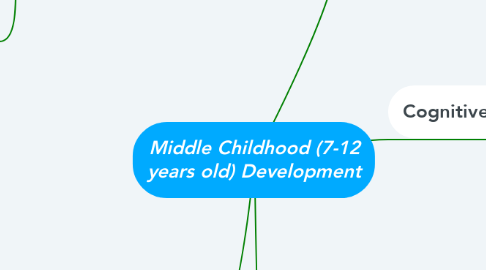
1. Physical Development
1.1. Development of gross motor skills including; hand, eye and foot coordination, and the recombination of existing motor skills incorporated into newly learnt skills. eg. the kicking, jumping and catching involved in playing a game of AFL.
1.2. The introduction of puberty for some, mainly females. Some begin puberty from as young as 9. Physical changes involved include; increase in height and weight, pubic hair, menstration and voice changes amongst other inclusions
2. Social, Emotional and Moral; Development
2.1. Understanding of Self
2.1.1. Self-identity is developed through school life and working with their peers. Teachers are used to reinforce a student’s competence when failure in an experience leads to self-doubt/ incompetence.
2.2. Understanding of Others
2.2.1. Moral Development
2.2.1.1. Can be developed though socialisation. Meaning that children construct their personal moral value through integration into the adult world. They construct their moral development through observing others and through relationships.
2.2.2. Emotional Development
2.2.2.1. Emotional Development includes the following competence’s; awareness of emotion, emotion vocabulary, empathetic and sympathetic behaviour, dealing with emotions etc.
2.3. Understanding Relationships with Others
2.3.1. Learning through play. A means used to encourage cooperative behaviours and development of relationships through using social competencies learnt prior. Cooperative play should be achieved through middle childhood.
2.3.2. Friendships are an important part of learning and developing social and emotional skills through middle childhood. Friendships become a mutual trust and assistance between the ages of 7-12. For these relationships to be maintained they require cooperation and high self-perception.
3. Language Development
3.1. There are three main symbolic recognisers of language development within the ages of 7-12, these include; increase use in abstract words, increase understanding of written and verbal grammar and a larger word bank (length in vocabulary).
4. Cognitive Development
4.1. Piaget’s Theory
4.1.1. Children explore through experimentation with the environment in order to construct schemas. This theory is aligned directly with the ideas of constructivism.
4.1.2. The stages of Cognitive Development: Middle Childhoods stage lies in the Concrete Operational Stage. The main developmental milestone of this stage is said to be, conservation. This is where children understand that objects and quantity, despite their physical characteristics and appearance remain the same.
4.2. Vygotsky’s Theory
4.2.1. Cognitive development is heavily dependable on ones social, cultural and historical upbringing and experience.
4.2.2. Understanding the zone of proximal development and adapting it to classroom activity is important in meeting the cognitive needs of learners. The usage of scaffolding as well as adapting activity’s to meet the cognition of learners are involved in successfully using the zone of proximal development.
4.3. Brain Development
4.3.1. Growth in the Limbic System. This influences children ability to recognise when they are being left out in social/group work/play.
